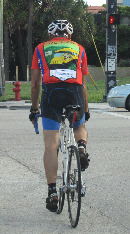Posts Tagged ‘cycling’
Hand me a drum, it’s National Nutrition Month. For people who are making an effort to live a healthier life, this month presents a great opportunity for inspiration; there will be great nutrition tips everywhere. Here are a few of my own (and this column might be a good one to clip for the refrigerator door).
Snack light. Snacking is unavoidable for all but a few, so why not just control the part you can? Kids follow good examples, so have fruit and veggies cut up and ready to enjoy, for both your sakes.
The freezer is your friend. Keep it stocked with fruits and veggies, too; they’re just as healthy as fresh, and then you can toss them into whatever you’re making.
Soft can be good. Soft fats (like olive oil) are so much better for you than hard fats (lard).
Deep Color, Good Health. Vivid, colorful vegetables (carrots, broccoli, peppers, tomatoes) are more nutrient-dense than pale celery, cucumbers, and mushrooms. Blue and purple fruits contain flavonoids (the most powerful phytochemicals in nature). Phytochemicals decrease the risk of cancer, cardiovascular disease, osteoporosis and more.
Avoid Cereal Killers. Choose cereals that contain at least 3 grams (g) fiber/serving, and no more than 6 g sugar/serving. And no trans fats!
Pack at Night. Preparing your next lunch before bedtime avoids a last-minute, access-and hunger-driven purchase of processed food. These few minutes of preparation can dramatically change the quality of your weekly intake. Stock your workspace with healthy snacks for preventive nutrition: whole-grain crackers, trail mix, fruit cups.
Fewer Legs, Fewer Risks. Meat which used to live on two legs is healthier for you than its four-legged counterparts. Protein that used to swim is packed with omega-3 fatty acids: great for your heart. Save cows and pigs for occasional indulgences, and think of them that way.
Be Pro-Digestion. Digestive health starts with fluid consumption, fiber intake, exercise, stress reduction and probiotics. Be proactive.
100 x 365 = 10. Cutting 100 calories per day could result in losing 10 pounds per year. That’s one fruity drink, the cheese on a burger, or a bag of chips. Smart substitutions pay off.
Fruit Juice: Upgrade, Downsize Switch from regular juice to calcium-fortified juice, but beware the serving size. Juice is not calorie-free, by any means.
No Curves Ahead. Decrease your risk of osteoporosis. Eat (and drink) calcium-rich foods for bone strength and density. Exercise helps too.
Life’s a Bowl of Cherries. Dried or fresh cherries are rich in vitamin C and fiber. They boost heart health, reduce the risk of cancer, and are rich in melatonin (which helps sleep).
My Take on the Cs. Carbohydrates do not cause fat. Calories do.
Be Proactive in Restaurants. A meal out can be healthier than the menu indicates. Ask for whole grain foods and brown rice. These are easy substitutions which make a difference.
Fiber Fights Hunger. Breads, cereals and pastas rich in fiber fight hunger urges and help with weight management. Just watch your serving sizes.
Whether you’re trying to lose weight, lower your sugar intake for overall well-being, or wean your kids off sugar, you need to recognize sugar in its many forms. It’s amazing how many different words mean “sugar” on the contents label of a food or drink.
It’s also unbelievable how many food products include sugar in one form or another. To boost to your wellness plan, you have to know sugar terminology, and you have to know how to interpret the label (and teach your kids). The top three ingredients listed on the label are primary, so if you see a sugary term there, the product is loaded.
Some ingredients to watch out for: corn sweeteners, evaporated can juice, cane sugar, high fructose corn syrup, confectioner’s sugar, dextrin, honey, invert sugar, maple sugar, raw sugar, malt molasses, turbinado sugar, brown and white sugars.
I was also taught, while earning my dietitian degree, that “if it ends in OSE, it means sugar.”
Sucrose, lactose, dextrose and maltose … Watch out!
Sugar has invaded many products where you don’t expect to find it. I’m talking about things such as salad dressings, canned foods, pasta sauces, lunchmeats, “healthy” cereals and granola bars, dried fruit snacks, and more.
It’s no wonder the average American consumes 128 pounds of sugar per year. Prepared foods are hiding pounds of sugar, and adding pounds of fat, especially to our kids, who are at grave risk for diabetes. (Ouch, that hurts me to just write that).
Hopefully you’re aware how much sugar is packed into a regular soda, but sports and energy drinks are culprits that often fly under the radar. Because their purpose is “beneficial,” these drinks make it easy to forget that their labels are also important. But that 20-ounce Powerade you rely on to hydrate you has more than 8 teaspoons of sugar in it!
Some other big offenders (teaspoons of sugar per drink in ounces)
- Propel: 1.5 tsp per 16 ounces
- Vitamin Water: 7 tsp per 20 ounces (this one surprised me).
- Regular Powerade: 8.3 tsp per 20 ounces *
* Powerade and Gatorade do have low sugar options.
Sports Drinks
- Full Throttle: 13.8 tsp per 16 ounces
- Jolt Energy: 22.3 tsp per 23.5 ounces
- Amp: 7.3 tsp per 8.4 ounces
- Monster: 12.8 tsp per 16 ounces
Other drinks that pack in the sugar
- 7-up: 9 tsp sugar per 12 ounces
- A & W Cream Soda: 11 tsp sugar per 12 ounces
- Average cola: 10 tsp per 12 ounces
- Nestlé’s Ice Tea: 8-14 tsp sugar per 16-20 ounces
The bottom line: high sugar intakes are contributing to an epidemic of obesity in this country.
 What cyclists eat and drink determines how fast and how far they can ride. What are your goals? Recreation, competitive racing, or heavy-duty triathlons? Even recreational riders should pay attention to their diet; maximize your ride and get the body you want. All athletes and exercisers need energy to function.
What cyclists eat and drink determines how fast and how far they can ride. What are your goals? Recreation, competitive racing, or heavy-duty triathlons? Even recreational riders should pay attention to their diet; maximize your ride and get the body you want. All athletes and exercisers need energy to function.
Many cyclists avoid caffeine, knowing it’s a diuretic, but here’s a surprise. During endurance exercise, the dehydrating qualities of caffeine are practically nil with small amounts of caffeine. And studies have shown that it may help the body burn fat, rather than carbohydrate reserves.
Coffee is not an ideal source of caffeine for exercisers or athletes – therefore, don’t think you can justify your Starbucks habit. We have only 1,500-3,000 calories of reserve carbs, but the body stores 70,000 fat calories at any given time, so burn, baby, burn.
Each hour of an intense bike ride will use 500-1,000 calories. Your overall protein needs will increase during exercise; supplement at 1.2-2. g protein per kilogram of body weight per day depending on your intensity and length of exercise.
For endurance events, you can increase your carbs three days prior. This maximizes the body’s glycogen stores. While you ride, you need 30-60 g of carbs for each hour beyond the first hour. An energy bar works.
Practice eating while you ride and don’t change your food choice on race day. Remember, fat can contribute as much as 75 percent of your energy demands during endurance training. Keep foods simple.
During a ride in hot weather, the body’s ability to digest becomes compromised. Liquid foods avoid this situation, and keep you speeding along without much hassle. Certain energy drinks can fill the bill, as does an Ensure protein drink, available in any drug store.
Ensure also comes in powder form; having baggies of it allows you to add it to water, drink a meal, and continue on. You can also mix fruit juice and water for a source of hydration, carbs and sugar for your blood.
Intro to 3-Part Series: Nutrition for Running, Cycling, Swimming
Over the next four weeks, I’m going to talk about proper nutrition for a variety of sports: running, swimming and cycling. Many Floridians participate in one or more of these physically demanding (but fun) outdoor activities. A few combine them for triathlons – my cap’s off to you.
And here’s the thing. The human body can excel at a demanding sport only when fueled correctly. This may shock you, but proper nutrition is at least 80 percent of the formula for successful exercise and athletic training.
Don’t be misled by my use of the word “training.” If you’re a soccer mom taking a lot of classes to keep your tush looking toned, you are training. Dads who cycle five nights a week to keep the effects of aging at bay are training. And, of course, if you’re an individual or team athlete striving for wins, records, medals or the like, you know I’m speaking to you.
But you can train seven days a week – devoting hours and hours of your life to your pursuit – and without giving your body what it needs to support and achieve those goals, you will not end up where you want to be, including in the weight department. You may not even come close.
Picture Kyle Busch on the track in Indianapolis, and his car without the right kind of gas and fluids. Nothing in his driving skills can overcome the fact that his vehicle is not fueled for the task, and your body is no different.
Sports nutrition has many components. Sure, it’s important what foods you include in your daily diet, be they carbs, protein, fats, sugar or liquids. Carbs and proteins both have specific functions. We must understand what our body needs, how it uses what we give it and how we can maximize what it naturally provides. This is how we learn to boost our energy reserves so we can train harder, build lean muscle and avoid storing fat.
As important as what an active adult eats is the timing of when it’s eaten. I’ll talk about how and why to “pre-load” for a workout, and how nutrition can speed up post-activity recovery. Much of our body’s healing from exercise takes place while we sleep, so nutrition for proper sleep is also critical.
Next week, we’ll start with nutrition for running. (If you spend time on the treadmill in your gym, this will apply to you.) All my running readers will gain a real footing on the road to success. It starts with nutrition.
You can improve performance by delaying dehydration
Hydration is often left out of nutrition, but it shouldn’t be. Staying hydrated is important not only to improving performance in sports and other activities, but it plays a vital role in helping maintain a balanced diet and healthy lifestyle.
Necessary to the healthy function of all internal organs, water must be consumed to replace the amount lost each day during basic activities. Water is also proven to aid in weight loss. It helps you feel full so you eat less, quenches thirst without adding calories and allows your body to function at its top capability.
Keeping hydrated helps muscles look more toned, a look that many people desire. Being hydrated also helps your skin look and stay healthy.
Water regulates the body’s temperature, cushions and protects vital organs, and aids the digestive system.
In 2004, the Food and Nutrition Board released new dietary reference intakes for water. It is recommended that women consume 2.7 liters daily and men consume 3.7 liters through various beverages, 80 percent, or in food, 20 percent.
Active individuals need even more, particularly if they’re exercising in hot weather. This is especially important during the 24 hours prior to vigorous exercise. During exercise, our body produces more heat, causing sweat to cool us down. When we sweat out our water supply, we must consume more water to keep our core temperature down.
In one hour of exercise, the body can lose more than a quart of water, depending on exercise intensity and air temperature. If there is not enough water for the body to cool itself through perspiration, the body enters a state of dehydration.
For people who regularly exercise, maintaining a constant supply of water in the body is essential to performance.
Dehydration leads to muscle fatigue and loss of coordination. Even small amounts of water loss may hinder athletic performance.
In a dehydrated state, the body is unable to cool itself efficiently, leading to heat exhaustion and possibly heat stroke. Without an adequate supply of water, the body lacks energy and muscles may develop cramps. To prevent dehydration, you must drink before, during and after a workout.
During exercise, water is the best fluid replenisher for most individuals, although sports drinks help replace lost electrolytes during high intensity exercise exceeding more than 60 minutes. Keeping hydrated can improve performance by delaying dehydration and maintaining balanced blood-sugar levels during exercise. It also lowers the risk of catching a cold by boosting your immune system.
Drink 17-20 ounces of water two to three hours before the start of exercise. Drink 8 ounces of fluid every 20 to 30 minutes prior to exercise or during warm-up. Drink 7 to 10 ounces of fluid every 10 to 20 minutes during exercise. Drink an additional 8 ounces of fluid within 30 minutes after exercising. Drink 16-24 ounces of fluid for every pound of body weight lost after exercise.
Water is your best option. Tea (non-caffeinated and unsweetened) and 100 percent juice, not cocktail drinks, are good alternatives if you just need something else. Sports drinks are also good for your body during and after exercise.
Coffee and alcohol don’t need to be nixed completely, but should be consumed in very small amounts. Two cups of coffee a day isn’t going to help your body and scientific evidence suggests alcohol consumption can interfere with muscle recovery after exercise and negatively affect a variety of performance variables.
As far as options that you should stay away from, soda is at the top of the list. While drinking one soda probably won’t hurt you, it provides little hydration. In fact, frequent consumption of soda can be more harmful to your body than any of the other drinks listed above, with the exception of alcohol.
In the end, staying hydrated by drinking water throughout the day and especially during exercise is highly recommended to support good nutrition and healthy living.
Elaine Hastings is a registered dietitian and owner of Associates in Nutrition Therapy in Fort Myers. Contact her at Elaine@eatrightRD.com or visit her at AssociatesinNutrition.com.





Follow Us!